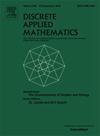Exploring algorithmic solutions for the Independent Roman Domination problem in graphs
IF 1
3区 数学
Q3 MATHEMATICS, APPLIED
引用次数: 0
Abstract
Given a graph , a function is said to be a Roman Dominating function if for every with , there exists a vertex such that . A Roman Dominating function is said to be an Independent Roman Dominating function (or IRDF), if forms an independent set, where , for . The total weight of is equal to , and is denoted as . The Independent Roman Domination Number of , denoted by , is defined as min{ is an IRDF of }. For a given graph , the problem of computing is defined as the Minimum Independent Roman Domination problem. The problem is already known to be NP-hard for bipartite graphs. In this paper, we further study the algorithmic complexity of the problem. In this paper, we propose a polynomial-time algorithm to solve the Minimum Independent Roman Domination problem for distance-hereditary graphs, split graphs, and -sparse graphs.
求助全文
约1分钟内获得全文
求助全文
来源期刊

Discrete Applied Mathematics
数学-应用数学
CiteScore
2.30
自引率
9.10%
发文量
422
审稿时长
4.5 months
期刊介绍:
The aim of Discrete Applied Mathematics is to bring together research papers in different areas of algorithmic and applicable discrete mathematics as well as applications of combinatorial mathematics to informatics and various areas of science and technology. Contributions presented to the journal can be research papers, short notes, surveys, and possibly research problems. The "Communications" section will be devoted to the fastest possible publication of recent research results that are checked and recommended for publication by a member of the Editorial Board. The journal will also publish a limited number of book announcements as well as proceedings of conferences. These proceedings will be fully refereed and adhere to the normal standards of the journal.
Potential authors are advised to view the journal and the open calls-for-papers of special issues before submitting their manuscripts. Only high-quality, original work that is within the scope of the journal or the targeted special issue will be considered.
 求助内容:
求助内容: 应助结果提醒方式:
应助结果提醒方式:


